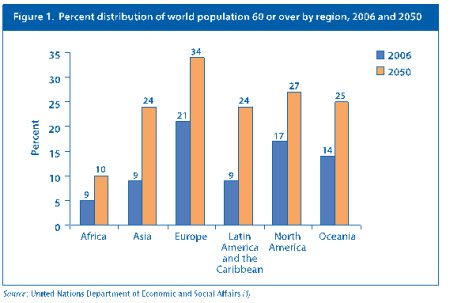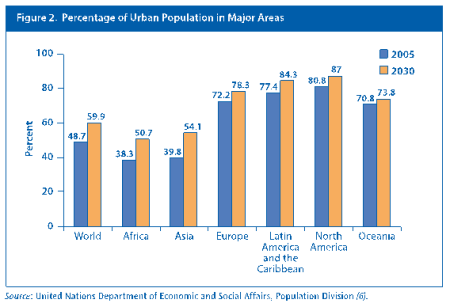By some estimates, 70 percent of seniors today are living in the same place they celebrated their 65th birthday, known as aging in place. This is rapidly changing the nature of many communities around the country that to their considerable surprise are now becoming “naturally occurring retirement communities” or NORCs.
While aging in place is nothing new—it is, after all, a pattern that goes back thousands of years—its impact today is dramatic because of the rapid growth of seniors in the United States. Over the coming decade, the population of Americans over the age of 65 will grow from 40 million in 2009 to over 56 million by 2020, an increase of 42 percent, according to the U.S. Census.
Before the advent of our affluent, choice-rich society, few people could choose where they aged. Nor did many people want to move away when they got older, surrounded as they were by family and a community of lifelong friends; often they were respected, even revered, as they aged.
The situation is much the same today in traditionally blue-collar and lower-income neighborhoods in the United States, where families are less likely to move apart and where kids stay in the community as they grow up, going to nearby schools and getting local jobs. Where a community’s population is stable, there are family and friends available to support seniors as they age. A NORC in this context works well and seniors are often well cared for.
It is, however, the exception today for kids to stay near home as they grow up. In our highly mobile society, aging seniors seldom have much family nearby to support them and they must rely on the larger community around them. The extent to which a community can provide this support effectively is a product of many things, including especially its physical design, i.e., whether it is suburban or urban.
The Graying of the Suburbs
Seniors who remain in suburban homes find themselves in communities designed for families with young kids and cars. They may have many friends in the community, but their friends, shopping, and any needed services all require a car to reach; public transportation is generally scant or nonexistent.
Suburbs traditionally have been focused on provide schooling, not senior care. There may be a senior center or two provided by a church, but the major financial investments are in roads and schools. The politics of providing adequate care for a growing and dispersed senior population is new and uncertain, and comes at a time of newly constrained local finances.
As seniors age, the support needed grows and has to be provided where they live—either that, or seniors have to be brought to the service provider. Either way requires private cars, vans, and buses (and drivers) as few suburbs are designed for effective public transit. This adds to the cost of already expensive services as well as adding traffic, energy usage, and pollution. While technology is beginning to help provide distant medical monitoring and advice, most of the services needed cannot be provided virtually. These include the following:
- Social and recreational programs;
- Computer support and training;
- Continuing education programs;
- Information and counseling;
- Home maintenance and referral services;
- Emergency and preventive health care programs;
- Meal programs;
- Shopping for food and clothes; and
- Transportation.
Hardest of all to deliver, as the mobility of seniors declines, is a sense of community, without which they become isolated in large, decaying homes.
Suburban communities are just beginning to grapple with this new reality. For instance, ULI Minneapolis, in partnership with the Regional Conference of Mayors, and the Center for Housing Policy in Washington, D.C., with support from the Family Housing Fund, has begun exploring ways to help suburban communities in the region rethink their housing strategies in light of the rise in the numbers of seniors aging in place.
One initiative the Minneapolis effort is encouraging is for communities to attract more young professionals to the community to balance the age of the population. While promising, this is likely to work better in suburbs that are close to job centers; this may work less well in those outer-ring suburbs less attractive to young families with two working parents.
Other efforts being considered by groups around the country include finding ways to encourage seniors to move in together; with large houses, there is room to create small group homes for seniors that make it easier to provide community and support. This also frees up seniors’ homes for new families with the energy and resources to maintain them.
Where there are nearby suburban town centers—satellites of urbanism near the communities where the seniors have been living—it is also possible to encourage the development of “urban” housing for seniors that allows them to remain near their community of friends while gaining the benefits of aging in an urban setting.
Cities Serving Seniors
Urban neighborhoods, in fact, have many advantages over the suburbs for seniors, from better transit and health care to a healthier lifestyle made possible by living in walkable neighborhoods with a sense of community and human interaction. From a city’s standpoint, a growing population of seniors presents many advantages. For example, seniors pay taxes but do not require schools (or can use existing schools during off hours), have low crime rates, support the arts and cultural activities, and are often active in civic and volunteer activities.
Older seniors, however, do require the kinds of support that can put pressure on limited municipal services. Cities in the United States are only now beginning to respond to this new demand.
Globally, two broad demographic trends are converging:
- In 2000, the global population of people over 60 was 600 million; by 2025 there will be 1.2 billion, and by 2050 almost 2 billion. The proportion of the world’s population older than 60 is more than 11 percent today and will exceed 20 percent by 2020.
- In 2008, for the first time in history, the majority of the world’s population lived in cities and by 2030 approximately three out of every five people will live in urban areas.
In response to these trends, the World Health Organization (WHO) created the “Global Network of Age-Friendly Cities”. Beginning in 2006, WHO undertook an assessment of eight aspects of urban life that make cities age-friendly:
- Outdoor spaces and buildings;
- Transportation;
- Housing;
- Social participation;
- Respect and social inclusion;
- Civic participation and employment;
- Communication and information; and
- Community support and health services.
For each of these topics, a set of guidelines was created and published in “Global Age Friendly Cities: A Guide” along with a checklist.
Items on the checklist range from the specific, such as having sufficient seating in outdoor parks, to the very broad, such as having sufficient affordable housing in safe areas near services and the rest of the community. Membership in the network demonstrates a commitment by the city to apply these guidelines and work to improve its age-friendliness. To date, New York City and Portland, Oregon, are the only U.S. cities among the 35 listed in the WHO guide.
Despite a limited response so far to the WHO program, many American cities are looking for ways to meet the needs of growing senior populations. Some examples are as follows:
- Using schoolbuses to transport seniors to shopping after the buses have taken kids to school (New York City);
- Modifying planning and zoning rules to accommodate accessible housing (Portland, Oregon);
- Encouraging the creation of lifelong communities by linking housing, transit, basic and preventive health care, and easy access to services (Atlanta Regional Commission);
- Creating “aging improvement districts” where, among other things, stores commit to put out chairs for seniors, use larger signs, and keep aisles open; and the timing of traffic lights is lengthened to give seniors more time to cross streets (New York City). New York now has three such districts.
Simple things like benches at transit stops, access to bathrooms, zoning that allows seniors to rent out upper portions of their homes, well-maintained sidewalks that help seniors avoid falling, and places to walk separate from bicycles all make a large difference for the aging.
In the years ahead, most American suburbs and cities will be devoting an increasing amount of scarce community resources to meeting the needs of growing populations of seniors. The task of meeting the needs of seniors generally will be easier the more urban a community is. Housing the growing senior population is not just a matter of finding age-appropriate housing; it is also a matter of creating age-appropriate communities for them to live in as they age.






